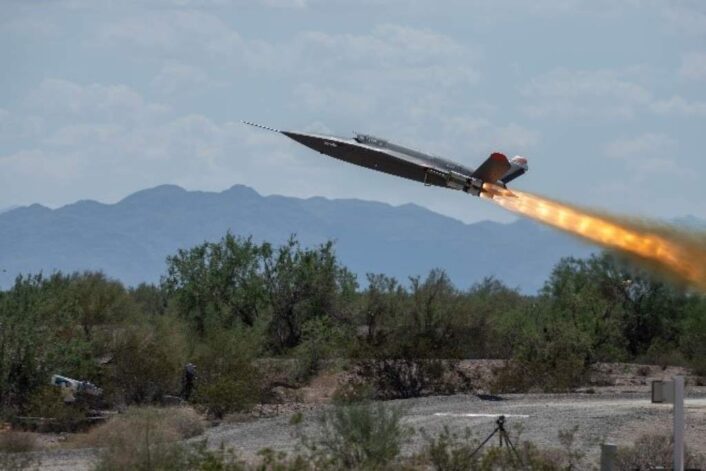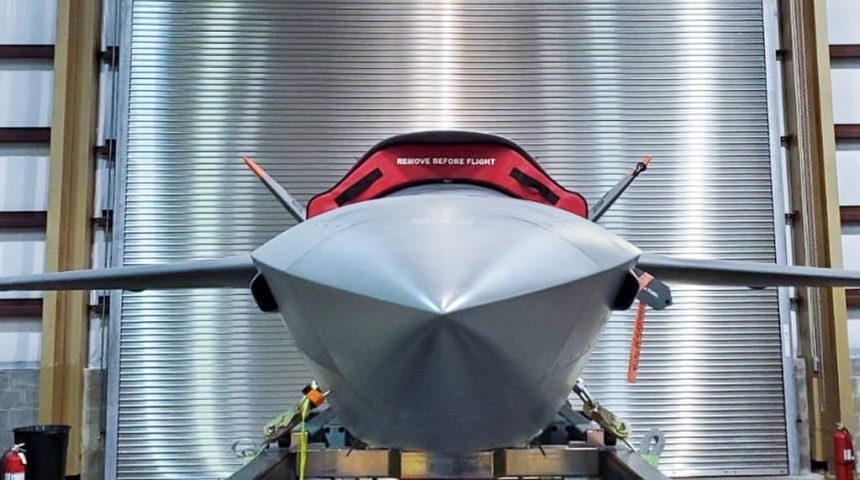The first military-owned Valkyries will exploit Eglin Range’s infrastructure to further expand the test campaign.
The 40th Flight Test Squadron ar Eglin Air Force Base, Florida, took possession of the first of two government-owned Kratos XQ‑58A Valkyrie low-cost, high-performance unmanned aerial vehicles. The Autonomous Aircraft Experimentation team established within the unit will use the XQ-58 and Eglin range for further developmental ground and flight testing.
Until now, the majority of the Valkyrie’s testing has been carried out at the Yuma Proving Ground in Arizona, which is run by the Army, with aircraft owned by Kratos. At Eglin, because military ownership of the XQ-58A is new, much of the aircraft’s infrastructure and logistics have to be created from the ground up and will be recorded, according to Maj. John Nygard, 40th FLTS AAx team lead.
“When you combine the XQ-58A with the Eglin Range infrastructure, you get an uncrewed aircraft that enables real, open-air test of flight autonomy software capabilities while also proving out the resource requirements that could be used for future combat collaborative aircraft,” Nygard said. The AAx team will test autonomous aircraft in partnership with the Air Force Research Laboratory Strategic Development Planning and Experimentation office.
The resources available at the Air Force-owned military range are a major reason XQ-58A testing found a new home at Eglin. The Eglin Range communications support infrastructure will allow engineers at the ground station in the Central Control Facility to monitor the vehicle’s performance during flight. Additionally, autonomous aircraft operations, airspace, and safety processes have been developed to enable safe and effective flight testing for uncrewed air vehicles.
“The data generated during previous tests, along with feedback provided from our user community, show that in order to rapidly develop and mature tactical autonomy on an appropriate timeline, investment in, and utilization of, appropriate military range resources is required,” said Matthew Niemiec, AFRL autonomous aircraft experimentation portfolio lead.
The Valkyrie was instrumental for multiple Air Force test activities in recent years. In 2020 the drone acted as a datalink and translator between an F-22 and an F-35, while in 2021 it launched from its weapons bay a smaller ALTIUS-600 drone, also known as Air Launched Effect. Nygard described this new round of tests as time-critical, with a lot to get done in a short amount of time. “The goal by fall 2023 is to leverage this platform for experimentation with crewed-uncrewed teaming display solutions” said Nygard.
Additionally, the team is building out a data-storage and simulation environment to capture operator feedback and integrate their inputs into the autonomy software development process. The XQ-58A could host a variety of flight autonomy software solutions that were first tested in the simulator, including those from the Skyborg Autonomy Control System and others provided by third-party government and industry partners.
In fact, Niemiec said AFRL is working with multiple industry partners to integrate leading-edge autonomy capabilities onto the XQ-58A. “The simulation investment enables us to focus flight test efforts of XQ-58A on developing the process to deliver autonomy software capable of accomplishing operator-defined missions to the warfighter,” he said.

Meanwhile, Kratos has recently completed a successful flight of the production XQ-58A for the Block 2 Valkyrie Maturation Program. “The test flight performed at Yuma Proving Ground proved XQ-58A’s extended capabilities by flying longer, higher, at a heavier mission weight, and at a longer range than the platform has previously been approved for (based on prior government range limitations) and demonstrated”, said the company in a statement.
Kratos did not provide details about how much the performance have been increased. Describing the baseline Block I XQ-58A, the company’s website says it’s designed with a maximum launch weight of 6,000 pounds, can fly at altitudes up to 45,000 feet above sea level, and has a maximum range of about 3,000 miles.
The flight was conducted with and demonstrated encrypted communications with redundant radios/communications packages for range and operational missions remote from government ranges. For the final test point, the aircraft navigated to the landing site in a simulated loss of communications scenario. It landed within the target zone, demonstrating key autonomous capability for the ending the mission and recovering the aircraft without radio comms. This capability will help mitigate the possibility of enemy detection and tracking of radio frequency emissions as the system returns to base.
This flight test was also a key milestone in Kratos’ support of AFRL’s Autonomous Collaborative Enabling Technologies (ACET) portfolio, says Kratos. ACET is focused on developing Autonomous Collaborative Platforms (ACP) such as Collaborative Combat Aircraft (CCA), as “loyal wingman”-type UAVs are formally known. Thanks to the results of this flight, Kratos says the XQ-58 is ready for future ACP experimentation.
While testing continues at high pace, other operators might soon join the U.S. Air Force and begin flying the XQ-58. “We now expect two new Valkyrie-related tactical drone system contract awards from two separate new customers from multiple aircraft,” said the company’s President and CEO Erik DeMarco during a recent earnings call. “And we have just recently begun discussions with a potential fourth new customer, also from multiple Valkyrie systems.”








